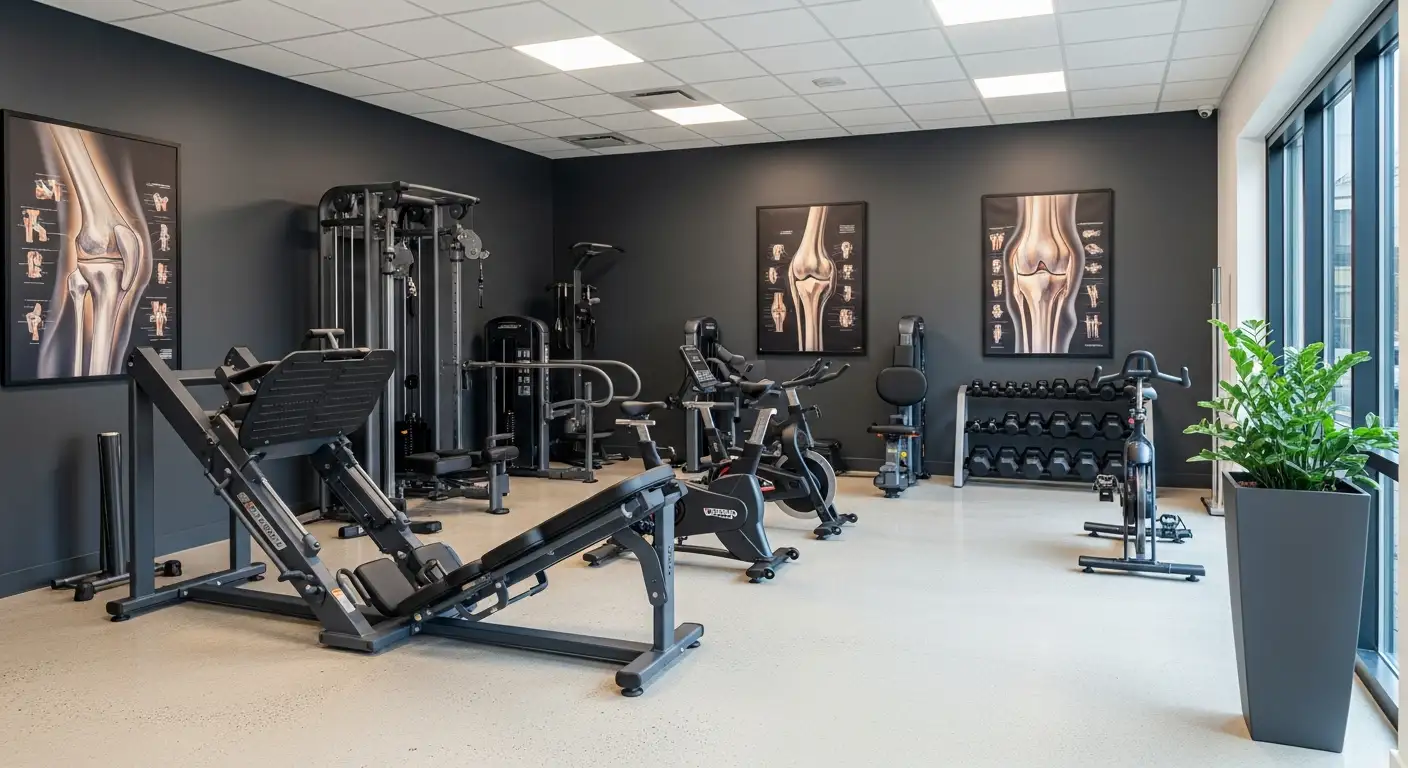Understanding Knee Extension Muscles
Importance of Quadriceps Muscle
The quadriceps muscle plays a vital role in the mechanics of the knee joint. It is composed of four muscles: rectus femoris, vastus lateralis, vastus medialis, and vastus intermedius, collectively recognized as one of the most powerful muscle groups in the body. These muscles converge on the quadriceps tendon, which attaches to the superior pole of the patella. The strength of the quadriceps significantly influences various physical activities, as it acts as the agonist muscle for knee extension.
Knee extension exercises specifically target the quadriceps, enhancing not only muscle strength but also functional activities. According to the Mayo Clinic, when the quadriceps is strong, activities such as walking, running, jumping, and squatting become easier, promoting better overall mobility.
Role in Daily Activities
Knee extension muscles are crucial for performing daily tasks effectively. They aid in essential movements such as climbing stairs, getting up from a chair, and walking, especially when navigating inclines or declines. These muscles also contribute significantly to sports-related activities, including kicking, jumping, cycling, running, and participating in games like basketball that involve sudden movements and jumps.
The table below summarizes the common activities where knee extension muscles are heavily involved:
| Activity | Role of Knee Extension Muscles |
|---|---|
| Climbing Stairs | Provides strength to lift the body upward. |
| Standing Up from a Chair | Engages muscles to push the body upright. |
| Walking | Stabilizes the knee and propels the body forward. |
| Running | Facilitates knee lift and propulsion. |
| Kicking | Controls the force and accuracy of the kick. |
| Jumping | Generates upward force for takeoff. |
In summary, understanding the importance and functionality of knee extension muscles, primarily the quadriceps, is essential for optimizing mobility and enhancing athletic performance. For further insights related to knee health, consider exploring our articles on knee popping out of place and knees pop when squatting.
Anatomy of Knee Extension Muscles
Understanding the anatomy of knee extension muscles is essential for comprehending their function and the potential injuries associated with them. This section discusses the composition of the quadriceps muscle group and the structure of the extensor mechanism.
Quadriceps Muscle Group Composition
The quadriceps muscle group is fundamental for knee extension and consists of four muscles: the rectus femoris, vastus lateralis, vastus medialis, and vastus intermedius. These muscles converge to form the quadriceps muscle tendon, which attaches to the superior pole of the patella [1].
| Muscle Name | Function | Location |
|---|---|---|
| Rectus Femoris | Knee extension, hip flexion | Anterior thigh |
| Vastus Lateralis | Knee extension | Lateral thigh |
| Vastus Medialis | Knee extension | Medial thigh |
| Vastus Intermedius | Knee extension | Beneath rectus femoris |
The quadriceps tendon is further described as a trilaminar structure formed by the tendons of these muscles, exhibiting complex anatomical variations. For those interested in detailed anatomical ratios, the Insall Salvati Ratio may provide insights into knee mechanics.
Extensor Mechanism Structure
The extensor mechanism of the knee comprises multiple components that work together to facilitate movement and stability. The retinacula of the extensor mechanism consist of connective fibers from the quadriceps muscle group, including the patellofemoral, vastus medialis, medial collateral, patellotibial, and medial patellomeniscal ligaments. These ligaments provide stability to the osseous components of the knee [1].
The patellar tendon originates at the inferior pole of the patella, inserting into the tibial tuberosity. This tendon is also crucial for knee extension. The vascularization of the patellar tendon comes from three pedicles on each side, originating from different arteries, which ensures adequate blood flow to support functionality and healing.
Additionally, the nerve anatomy of the knee extensor apparatus is mainly composed of the infrapatellar branch of the saphenous nerve, which innervates the extensor mechanism. Understanding these components is vital for diagnosing issues related to knee pain and ensuring effective rehabilitation.
For more information on knee injuries and recovery, you can explore topics such as calf tear recovery time or how to address instances where knees pop when squatting and knee popping out of place.
Common Knee Extensor Injuries
Knee extension muscles, particularly involving the quadriceps, can be susceptible to various injuries. Understanding these conditions can help in recognizing symptoms and seeking appropriate treatment.
Quadriceps Tendon Ruptures
Quadriceps tendon ruptures are severe injuries where the tendon connecting the quadriceps muscle to the patella (kneecap) tears completely. These injuries have an incidence of approximately 1.37 per 100,000 people. They predominantly affect male patients over the age of 40. Symptoms typically include pain, swelling, and difficulty in extending the knee NCBI Bookshelf.
| Factor | Details |
|---|---|
| Incidence Rate | 1.37 per 100,000 people |
| Common Demographic | Males over 40 |
| Symptoms | Pain, swelling, inability to extend knee |
Patellar Tendon Ruptures
Patellar tendon ruptures, which occur when the tendon connecting the kneecap to the tibia (shinbone) tears, are less common, with an incidence of about 0.68 per 100,000 people. This type of injury is more prevalent in athletes under 40 years of age. Patients suffering from such ruptures may experience similar symptoms to quadriceps tendon tears, including severe pain and functional impairment NCBI Bookshelf.
| Factor | Details |
|---|---|
| Incidence Rate | 0.68 per 100,000 people |
| Common Demographic | Athletes under 40 |
| Symptoms | Severe pain, functional impairment |
Patellar Dislocations
Patellar dislocations occur when the kneecap slips out of its normal position, constituting about 3% of all knee injuries. This injury is particularly common among younger individuals, with approximately 70% of cases occurring in patients under 20 years old. Activities like dancing, athletics, and specific military exercises increase the likelihood of this injury. The incidence of dislocations tends to decrease with age NCBI Bookshelf.
| Factor | Details |
|---|---|
| Incidence in Knee Injuries | 3% |
| Common Demographic | Patients under 20 (70%) |
| Risk Activities | Dancing, athletics, military service |
Recognizing these knee injuries can lead to timely intervention and management, reducing the risk of long-term complications. For further insights on knee conditions, including popping sounds during movement, visit our page on knees pop when squatting or learn about knee popping out of place.
Rehabilitation of Knee Extension
Restoring proper function to knee extension muscles is crucial for mitigating knee pain and improving mobility. Rehabilitation focuses on two main strategies: strengthening exercises and stretching techniques.
Strengthening Exercises
Strengthening exercises primarily target the quadriceps, the main muscles responsible for knee extension. These workouts help restore a full range of motion, improve muscle strength, and alleviate stress on the knees. The following exercises are recommended:
| Exercise | Description | Sets | Reps |
|---|---|---|---|
| Straight Leg Raises | Lying flat, lift one leg straight up while keeping the other leg bent. | 3 | 10-15 |
| Wall Sits | With back against a wall, slide down into a seated position for a set duration. | 3 | 20-30 secs |
| Step-Ups | Step onto a raised platform with one foot, then back down, alternating legs. | 3 | 10-12 |
| Leg Extensions | Using a leg extension machine, extend the legs while seated. | 3 | 10-15 |
These exercises not only strengthen the quadriceps but also contribute to reducing overall knee pain and improving functionality. Regular practice of these movements can lead to noticeable benefits in about six weeks, although individual results may vary, particularly following surgery or injury [2].
Stretching Techniques
Stretching techniques are equally important in rehabilitation, as they help maintain flexibility and prevent tightness in the hamstring muscles. Tight hamstrings can restrict knee extension. Incorporating the following stretches can be beneficial:
| Stretch | Description | Duration |
|---|---|---|
| Hamstring Stretch | While sitting or standing, bend at the hips and reach towards your toes. | 20-30 seconds |
| Quadriceps Stretch | Stand on one leg and pull the opposite foot towards your glutes. | 20-30 seconds |
| Calf Stretch | Stand facing a wall, place one foot back, and lean into the wall. | 20-30 seconds |
For optimal results, individuals are advised to move muscles through their full range of motion and perform stretching movements slowly [2]. Engaging in these exercises and stretches consistently aids in enhancing the functionality of knee extension muscles. Following these protocols can significantly contribute to recovery from knee pain and prevention of future complications. Additional methods such as ice therapy, compression, and elevation should also be considered for reducing pain and swelling.
Benefits of Knee Extension Exercises
Knee extension exercises primarily target the quadriceps muscles. These exercises provide numerous advantages, particularly in improving knee mechanics and enhancing overall health.
Improving Knee Mechanics
Knee extension exercises are vital in strengthening the knee extensors, especially the quadriceps group, which comprises the vastus intermedius, vastus medialis, vastus lateralis, and rectus femoris. This muscle group plays a crucial role in various daily activities, including climbing stairs, standing from a seated position, and walking downhill [3].
Strong knee extension muscles increase stability and support during movement, making activities like walking, running, jumping, and squatting easier [4]. The improvement in knee function leads to better performance in physical activities and reduces the risk of injuries, such as knee popping out of place or discomfort while exercising. For more insights on knee health, see our article on knee popping out of place.
| Benefits of Improving Knee Mechanics |
|---|
| Enhanced stability during movement |
| Easier execution of daily activities |
| Reduced risk of injury |
| Improved athletic performance |
Importance for Overall Health
Knee extension exercises are not only beneficial for knee mechanics but also significantly contribute to overall health. Engaging in these exercises helps manage and reduce pain associated with various knee conditions, such as patellar tendinitis, jumper's knee, and patellofemoral syndrome [2]. By alleviating such pain, individuals can remain more active, thereby promoting better cardiovascular health and maintaining a healthy weight.
Additionally, regular knee extension workouts can enhance joint flexibility and mobility, which are critical as individuals age. Maintaining strong and functional knee extension muscles plays a significant role in reducing risks associated with immobility and other health complications that arise from inactivity.
Incorporating knee extension exercises into a fitness routine ensures that the knees remain strong and functional, allowing for a more active and fulfilling lifestyle. For other beneficial movements, consider exploring band stretches or preventive measures for knee injuries.
Enhancing Knee Functionality
Knee functionality can be significantly affected by various conditions, leading to pain and reduced mobility. Understanding how to manage knee pain and promote mobility is essential in maintaining healthy knee extension muscles.
Dealing with Knee Pain
Knee extension exercises play a vital role in alleviating discomfort and improving knee function. Conditions such as patellar tendinitis, jumper's knee, and patellofemoral syndrome can benefit greatly from these exercises. Research indicates that focused knee extension movements help minimize pain and improve the overall health of the knee joint [2].
When dealing with knee pain, a gradual approach to rehabilitation is recommended. Strengthening the quadriceps through targeted exercises while simultaneously stretching the hamstrings can lead to noticeable improvements in pain management and mobility within about six weeks. Nonetheless, patients recovering from operations, such as total knee replacements, might experience different timelines for recovery.
| Timeframe | Expected Outcome |
|---|---|
| 1-2 weeks | Initial pain reduction observed with range-of-motion exercises |
| 3-6 weeks | Increased strength and improved mobility with knee extension exercises |
| 6+ weeks | Enhanced stability and function, pending surgery status |
Promoting Mobility
To maintain knee health, effective knee extension is crucial. Knee extension aids in balance and facilitates activities such as standing and walking without discomfort. Conversely, limitations in knee extension can lead to an altered gait, imposing additional stress on the knees and surrounding muscles, potentially resulting in pain [2].
Incorporating stretches and strengthening exercises into a daily routine can enhance mobility. Effective interventions include:
- Quadriceps Strengthening: Activities like straight leg raises and wall sits can strengthen the quads, promoting better knee extension support.
- Hamstring Stretching: Regularly stretching the hamstrings, such as through band stretches, facilitates improved mobility by countering tightness that may hinder full knee extension.
- Knee Stability Exercises: Balance exercises can enhance overall knee functionality and prevent further pain.
For additional guidance, explore exercises for managing stiffness following surgery at our article on exercise for stiff knee after surgery or learn more about preventing knee popping issues at knees pop when squatting.
Addressing knee pain and enhancing mobility are essential components in maintaining healthy knee extension muscles. Through a combination of dedicated exercises and stretching techniques, individuals can significantly improve their knee functionality and quality of life.





